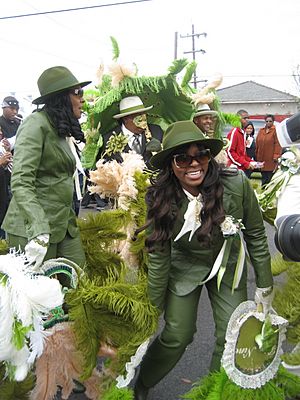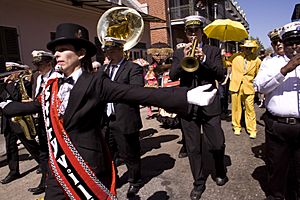Second line (parades) facts for kids
The Second Line is a special tradition in New Orleans, Louisiana, United States. It involves lively parades with brass bands. These parades are organized by groups called Social Aid and Pleasure Clubs (SAPCs).
Imagine a parade: the "main line" or "first line" includes the SACP members and the brass band. The "Second Line" is made up of everyone else! These are people who follow the band. They enjoy the music, dance, and celebrate together. The unique dance style, where people walk and dance freely with parasols and handkerchiefs, is also called "second-lining." It's a very important part of Black American culture in the United States. Some people call it "a jazz funeral without a body." Unlike jazz funerals, Second Line parades usually don't have slow, sad songs.
Contents
Discovering the Roots of Second Line Parades
The Second Line tradition comes from old West African circle dances. Enslaved Africans brought this tradition to New Orleans. It became a special ritual for African Americans, especially during processions like funerals. Some experts believe these dances changed from circles to lines. This happened as children drummed and adults danced.
The dance steps are often exaggerated and stylish. They are similar to dances once performed in Congo Square. Enslaved people were given Sundays off to gather there. These dances were once banned because they worried the city's white residents. Their return in the Second Line shows a celebration of freedom.
How Social Aid and Pleasure Clubs Started
African and African-American traditions continued even during tough times. These included the "Code Noir" and Jim Crow eras in New Orleans. African Americans formed groups like Benevolent Societies and "Social, Aid & Pleasure Clubs." They did this because white Insurance companies often refused to help them.
SAPCs helped their members when they were sick. They also supported families with money for burials. This idea came from African traditions. These traditions believed in celebrating a person's spirit leaving the body. This led to what is known as a "jazz funeral." In these funerals, SAPC members march slowly with a brass band. After the burial, a joyful parade begins. The same clubs also hold colorful, annual Second Line parades. These parades go through their home communities.
The Beat of Second Line Drumming
A special snare drummer often follows the brass band. This drummer plays unique, layered rhythms. These beats can inspire the dancers. They can also inspire the band members themselves. Second Line drumming styles became a key part of early jazz music. They also influenced New Orleans Rhythm and Blues in the 1950s.
Bands like the Rebirth Brass Band and the Dirty Dozen Brass Band use these traditional drumming styles. Famous drummers like Billy Higgins and Idris Muhammad also used Second Line drum patterns in modern jazz.
Second Lining Today: A Living Tradition
Second Line parades are a big part of New Orleans's cultural heritage. The most well-known parades are held by clubs and organizations. Some of these groups have been around for a very long time. The Young Men Olympian Junior Benevolent Association, started in 1884, is the oldest.
During "second line season," which lasts most of the year, parades happen almost every Sunday. There are breaks for holidays like Mardi Gras and the hottest summer months. Longer parades often stop at places like bars. Here, members can get refreshments. People following the parade can also buy drinks and street food. This often includes barbecue and yaka mein.
More Celebrations with Second Lines
People also hold smaller or larger second lines for other events. If someone wants to celebrate in this special way, they might hire a band. This includes events like weddings or opening new businesses.
The neighborhoods of Tremé and Central City are famous for these traditions. But you can also see second lines in the Seventh Ward, Uptown, Marigny, Ninth Ward, and Mid-City. The New Orleans Jazz & Heritage Festival also features second lines. This gives visitors a taste of this New Orleans tradition.
Second Line parades have appeared in movies and TV shows. The 1973 James Bond film Live and Let Die featured one. The HBO series Tremé also showed Second Line parades. Journalists have praised this unique culture.
The Second Line culture has kept its organized schedule throughout history. Clubs enjoy their annual parades. These events help the local economy. The clubs never lost their African-based traditions. They quickly brought back their parades after Hurricane Katrina. The Black Men of Labor held the first SAPC Second Line parade in October 2005. New residents of New Orleans have also embraced the tradition. Parade routes are often shared online, inviting everyone to join.
Second Line Parades in Other Places
This unique New Orleans tradition has spread to other parts of the country. The HONK! Festival in Somerville, Massachusetts, was started by a Second Line band. Asheville, North Carolina, has its own Asheville Second Line Band. They march in parades and local events. Oakland, California, has a growing Mardi Gras celebration. It includes parades organized by the Oakland Second Line Project. In Duluth, Minnesota, a puppet troupe hosts an annual "Run, Smelt, Run!" second line parade. This celebrates the smelt run each spring.
The magazine of the New Orleans jazz club, The Second Line, started in 1950. It took its name from this tradition. By then, fans of jazz music, both Black and white, were also "second lining."





